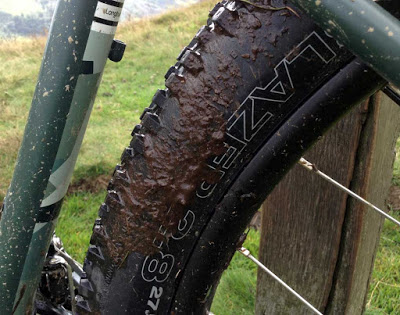 |
| Mud clearance isn’t a problem, neither was finding mud to try it. |
Componentry … I’m a big fan of things that ‘just work’ and my drive train allegiances lie in the Shimano camp, so you can imagine just how happy a bunny I was, riding something decked out front to back in Shimano Deore. Both, go and stopping duties are taken care of and at no point did I wish for anything else, other than the components fitted. Okay, Deore might not be at the top of your wish list but no one can deny that it works and not only does it work but it works very well. I was also happy to see three chainrings bolted to the cranks, at the moment it flies in the face of what’s popular … or to put that a different way – what’s trendy. Remember, this is a bike that’s meant to be taken anywhere and everywhere. Given that the rear 10 speed cassette is 11t – 36t and the middle ring’s a 30 toother, many riders probably won’t trouble the left hand shifter that often but there’s likely to be times when the 22t and 40t rings, will prove extremely welcome. Personally, I think their inclusion on the spec’ sheet says a lot about the thinking behind the bike … I’m sure it would have been easier and more cost effective for Genesis to follow the almost expected path of 1 x 10 but I for one, am glad they didn’t.
When things took a downward turn the Deore brakes did a great job of preventing anything from getting too out of hand. Anyone who’s ever suffered from brake fade will no doubt recall that moment, when the joy of descending turned into terror as you realised, that stopping had ceased to be an option. On one occasion, I’d reached what appeared to be a dead end but a little investigation lead me to be peering over what seemed to be the edge of the world. For a second or two, I did wonder whether what I was looking at, was actually rideable. The bike’s fitted with sensibly sized 180mm and 160mm discs, which I’m glad to say did a great job of allowing me to reach the bottom of this particular track unscathed and without any ‘moments’. I really did make them work, when you’re riding down something that’s 55 degrees plus, with no discernible run out, there really isn’t many options to give your brakes a breather … I think it’s fair to say, that the bike comes well specced in terms of providing forward movement and also retarding it.
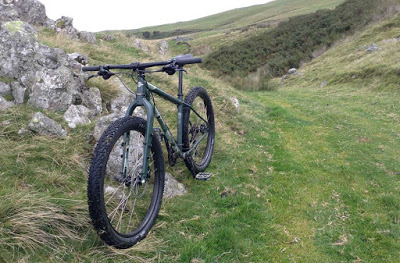 |
| No one enjoys grassy climbs but it performed very well. |
Chassis … There’s something nice about steel frames. People talk about it a lot, they talk about compliance, comfort and the forgiving nature but I like the word ‘nice’ … as with so many four letter words, it’s ability to convey a message goes way beyond its stature. This is a nice frame, there’s nothing pretentious about it but it does have some well thought out, practical touches – tapered headtube, sliding dropouts, rack mounts (although they were missing on this one), shimmed dropper compatible seatpost size, two cage mounts (one under the downtube) and a standard 135mm spaced backend. Even with the 2.8 TrailBlazer, there’s plenty of clearance, so things shouldn’t get clogged up even in the claggiest of winter conditions and perhaps there’s the possibility of squeezing in a bigger tyre for those who believe there’s a benefit to be had – see, what did I tell you, it’s a nice frame.
The fork isn’t steel and nor is it carbon, it’s aluminium. You may think that seems like an odd move, I did. Compliance, comfort and forgiving aren’t words you usually associate with aluminium. There are reasons why the fork is aluminium, I won’t bore you with them but I will tell you that it is most definitely rigid. It’s not a bad fork, it’s a good fork, combined with the through-axle and tapered steerer, the thing tracks brilliantly, there’s no braking judder or flex under any conditions but the trade off is stiffness. Those who already sport forearms like Popeye will probably notice just how rigid the fork is – as I’ve already said, it is stiff. However, if this is your first foray into the world of fully rigid bikes, then chances are they’ll behave exactly as you anticipated and you won’t think twice about it. Obviously, the large volume tyre helps cushion you from much of the feedback but it can’t remove it entirely. Surprisingly, on rough, rocky surfaces it was fine and felt as smooth or even smoother than many other rigid bikes, which must be a benefit of the tyres and to a lesser degree, the steel frame. The places I ‘noticed’ the fork, were those where the front of the bike had to deal with a ‘direct hit’, such as drops and steps. Nothing nasty or untoward happens but you do feel it. I don’t think it’s a deal breaker or even comes close and it certainly wouldn’t prevent me from investing in the bike … I’ve ridden far more ‘rigid’ steel forks before and I’m sure the effects could easily be lessened with a more compliant handlebar or even just slightly softer grips.
Something the fork does have plenty of, is mounts, there’s a three bolt cage mount on each leg and rack mounts for those who prefer that way of doing things … the bike even arrives with a pair of Gorilla cages, which I think is a nice touch. Another point of note, is the forks are spaced at 110mm, this is the new ‘Boost’ standard and actually makes a lot of sense but it’s something you’ll need to remember if you want to swap wheels, fit a dynamo hub, etc.
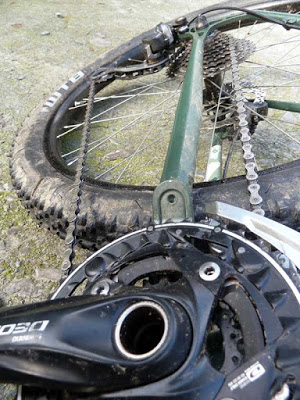 |
| Shimano Deore front, middle and back. |
I’ve always been a little sceptical about 650b, everyone I’ve ever ridden has been nearly impossible to distinguish from something fitted with 26″ wheels. This on the other hand, feels very much like a 29er, an agile 29er, one with lots of grip and a strange ability to almost float across the ground. If I had to describe it in one word, I’d probably pick – neutral. I know that might sound like a dull word in an industry full of ‘gnarly’, ‘rad’ and ‘stoked’ but trust me, in the real world, where bicycles actually get ridden from A to B, it’s a very desirable trait.
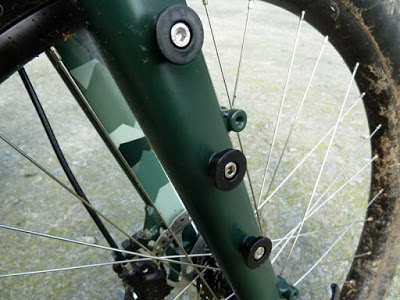 |
| Cage mounts … water, lunch or shopping goes here. |
Albert, who designed both models, told me he designed this because he believed it would be a better bike than the last one and I think that for 80% of riders, in 85% of situations, he’s succeeded. If you can leave your ‘bigger must be better’ mindset behind and along with it your lust for 29+ tyres, you’ll find that the new Longitude retains most of the benefits of 29+ but has managed to shed nearly all of the associated downsides … in the real world it makes a lot of sense.
Available as a full bike or frame-set sometime around mid-November.
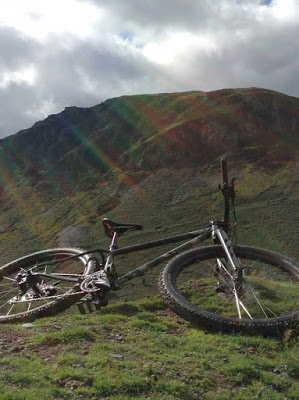
So it's a 'nice' bike.
I said it was a 'nice' frame and a very good bike …. don't underestimate the word 'nice' Meraid ;o)
I have to say I am one of the naysayers who bemoaned the loss of the 29 inch wheels, but thinking about it now, I have no idea why as I'm never going to buy one!
I have last year's Longitude and I totally love it. I bought it as my last big purchase before the birth of our daughter so it has to last me some years. It has to be a do-it-all bike, everything from grocery shopping, to tearing through the forest to maybe a bit of bikepacking. So far it's been great, I'm installing a child seat on it soon!
Anyway, the new Longitude looks fantastic, and I am slightly jealous of the fatter tires.
The 2015 model was / is a very good bike James and I do understand why some people thought the switch from 29" wheels was an odd one. However, the 2016 model really does ride in a very similar way to a 29er but brings along some of the benefits associated with plus sized tyres, with, as far as I can tell no real downsides.
The trailblazer tyre weighs 990g. Can't find the rim weight but given the DD28 is ~600g that seems reasonable estimate.
The chupcabra in 29+ weighs 850g and the mulefut rims weigh 655g and are 50mm.
29+ seems to have less sidewall height than B+ – I'm not seeing the weight difference in the tyres that I often see mentioned as a problem for 29+
I was down to get a 2015 Longditude – Genesis and EBC tried to sort me out, but I missed the last one in my size by days. The 2016 wasn''t for me – Boost in the front makes much less of a case for itself than boost in the rear. I think boost 110 is a missed opportunity, whereas boost 148 makes some sense – see 405 – 420mm on the Stache. I stupidly went for a stache 9 and proceed to take off the expensive bits and store them in the shed – I now have a rigid stache 9 with a normal seatpost and alu bars. If I was in the market, I'd be looking closely at the Stache 5 at £1300, which gives 1x, 100m forks and Boost 148 rear, plus the 655g mulefuts and 850g chupacabras.
The caveat is that I'm 6'2. For me, this is the key issue that will keep 29+ niche – you are running 31" wheels. The bike is going to be big.
I like 29+ too, especially as an option in the front and there will always be a demand for it. The point I was trying to make was that last years Longitude wasn't a 29+ bike. Okay, you could buy a frame set and spec your own but I suspect the vast majority of riders would simply buy a complete bike and add 3 " tyres … I think we both know, that doesn't work that well. So, I think for a lot of riders this platform / bike will make a lot of sense.
Although it's yet another 'standard', I think Boost has to be good at either end, even if it did nothing else it potentially provides better support for the wheel bearings due to the increased width.
The Stache 5 does look very good, if anyone at Trek would like to get in touch ……
I have to say that I have been close to buying 3" tyres for my 2015 Longitude, but in the end they simply cost a bit much for a family eeking along on half wages while my wife is still off on maternity. Definitely an upgrade for the future though. I'll possibly shorten the stem slightly too.
I was wondering about the rims and 3" tyres too. I know Surly Knards will fit on 35mm rims (according to the website) but wasn't sure if it would be a good move – you inadvertently answered that for me in your post 🙂
3" tyres such as the Knard will fit on 35mm rims James but my own opinion is that although they fit, you won't realise the benefits and in reality will just be carrying more weight about. The 2.4" X-kings your bike arrived with work very well on the 35mm rims … they make really good use of the tyres (quite large) volume.
Another bike to consider! 😮 sounds good 🙂
What sort of pressure do you recommend I run the current 2.4" X-kings at? I've been running them around 25psi for off road.
If you're running them tubed James, then maybe go 2-3psi lower but I wouldn't venture much below that.
I've got a 2015 model, purchased a full bike built and then sold off the crap brakes and swapped to 1×10 setup. 3" Knards front and rear on the stock Alex rims. I really don't get all this panning of 3" tyres on 35mm rims. Admittedly I haven't got a single other 29+ bike to compare this to, but my set up is an absolute hoot on fast an flowy stuff, but also handles rougher terrain as well as can be expected from a rigid bike. Pressures at around 12psi F/R. What magical properties will a few mm rim witdth bring to the table? I'm struggling to see it…
@James Davies – go for the 3" tyre mate!!
Carl, the extra width in the rims really does make a difference and gets the most from the increased tyre volume. Using narrower rims just means you're lugging round extra weight without getting the full benefit … with wider rims you'll be able to say " but also handles rougher terrain much better than can be expected from a rigid bike" ;o)